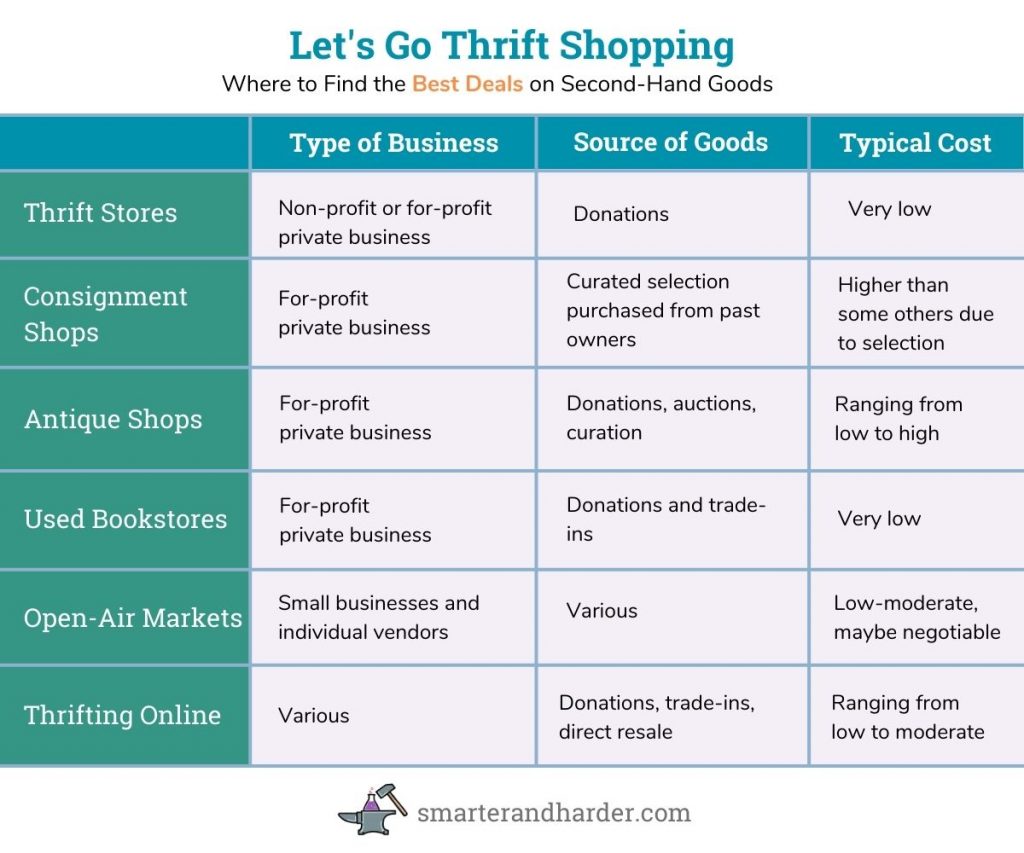Unlike some of the clothing you may find at a second-hand shop, the practice of thrifting itself never goes out of style. The long-lasting tradition of turning unwanted items into precious hidden gems lives on and thrives, benefitting buyers, sellers, donators, and often the community at large.
Here’s everything you need to know about the art of thrifting, so you can start discovering awesome finds and incredible deals next time you go thrift shopping.
What’s the Big Deal With Thrifting?
The purpose of thrifting for one person may not align with why someone else does it. But, of course, this outcome seems natural when you take a hobby that combines saving money, hunting for hidden treasures, and a sustainable effort to support local communities.
There are several great benefits that make thrift shopping awesome. Let’s take a look at some of the biggest.
The Economics of Thrifting
One of the biggest reasons thrifting remains such a popular way to shop is the financial side of it. Buying second-hand is a terrific way to save money and find higher quality unique items in the process.
Think about it: when someone is good at spending their money wisely, we literally call them thrifty!
Thrifted goods tend to have lower price tags than their still-in-packaging counterparts, but it’s not just that. They are also often of a higher quality than newer mass-market retail products. As a result, browsing your local thrift shop is a great way to find top name-brand items at a bargain basement price.
Second-hand goods have typically lost much of their marketability but little of their underlying value. For example, consider how a new car depreciates significantly the moment the first owner drives it off the lot. Is a car really worth 20% less after someone has driven it for a day, or do we sometimes give unreasonable value to the arbitrary quality of newness? That is the power of thrifting.
One final note, when you donate to a resale store, your donation is usually tax deductible. So it’s possible for all parties to save some money through thrifting.
The Psychology of Thrifting
As well as the financial reasons that thrifting makes sense, it also has some psychological benefits that buying new goods doesn’t.
Shopping is often an exploratory activity, a hunt for the eclectic and exciting. While we sometimes shop for a specific thing to meet a need, we often don’t know what we’re looking for until we find it. Thrifting is a great way to engage this hunt and find incredibly storied and unique purchases.
Many consumer goods these days are made to be purchased, used briefly, and then thrown in a landfill. This throwaway culture keeps us trapped on the hedonic treadmill and is a poor use of our planet’s resources. Thrifting gives new life to goods that have already fulfilled their service elsewhere. This sustainable approach to limiting consumer waste is highly emotionally rewarding to many thrifters.
Thrifting also lacks some of the psychological downsides of shopping new, such as excessive guilt or buyer’s remorse. Freedom from these uncomfortable feelings is often an emotional reward all its own.
Problems With Thrifting
There are a couple of minor risks and downsides to thrifting.
The most common of these is the risk of quality issues. One of the appeals of buying brand-new is the low risk of purchasing something damaged. And if it is, you are usually entitled to a refund or store credit. When you thrift a product, it has already lived a life, and that life may have left it with some scars. Thrift shop workers do their best to filter out or refurbish donations that aren’t in a condition to resell, but it’s hard to catch everything.
Another problem with thrifting is the potential to overdo it. The low guilt of buying second-hand that we discussed in the previous section isn’t always beneficial. A low emotional bar to clear for buying something can lead to overdoing it from time to time. An attitude of, “It’s only $6, I might as well,” can add up and become unintentional spending.
Where to Go Thrifting
It’s likely that when you think of thrifting, a specific place in your area comes to mind. Maybe it’s the used clothing store where you drop off annual donations from your wardrobe or a used book store where you love to search for beautiful old editions and super-cheap paperbacks.

One of the most fantastic things about thrifting is that there are many ways and places to do it, pretty much anywhere you live. Some are obvious, and some less so. Some are seasonal or only exist online. You can typically find a thrift option for almost any type of product, including:
- Gently used furniture
- Men’s and women’s clothing
- Purses and handbags
- Accessories
- Housewares
- Electronics
- Seasonal decor and home furnishings
- Sporting goods
- Toys, games, and puzzles
- Books and media
Fortunately, thrifting can accommodate practically any interest, style, or need. Let’s take a look at some of the most common options.
Thrift Stores
Thrift stores are the bread and butter of thrifting. Some focus on a narrow range of product types, such as clothing or furniture, whereas others have a more diverse inventory. It is common in many areas to find small, locally owned boutique thrift stores. There are also various large national and international thrift store chains, including:
- Goodwill
- Salvation Army
- Buffalo Exchange
- ReStore
- Savers
It is also worth noting that some thrift store chains, such as Goodwill, are non-profit charitable organizations, while others, such as Savers, are for-profit companies. The former are usually staffed by volunteers and support various charities with their proceeds.
Consignment Shops
To a shopper, a consignment shop may be very similar to a thrift store in that it sells gently used clothing and other merchandise at a discount.
The main difference between consignment stores and thrift shops is how they source their goods. Typically, everything for sale at a thrift store is donated, whereas consignment stores buy their used items from previous owners with the intent to earn a profit. Therefore, consignment stores tend to be more selective in their inventory and may charge higher prices.
While it’s valuable to know which type of resale shop you’re visiting, each one is different. So it’s always worth exploring and trying various stores in your area.
Antique Shops
While antiquing and thrift shopping are not always the same, there is significant overlap between the two. Antique stores are a great place to find unique treasures of a bygone era for reasonable prices.
Of course, some antiques you come across, such as collectibles, designer clothing, and artifacts of historical significance, can run a much steeper cost than new items. All the same, antique shops can be a great place to find deals on unique, high-quality household items, trinkets, and apparel.
Used Bookstores
Used bookstores are often some of the most charming resale shops around. Most cities and towns will have at least one.
These delightful little second-hand stores are often full of exciting finds, some of which may be out of print, at shockingly low prices. So if you’re a reader and have a used book store in your area, it could be the perfect spot to discover your next literary treasure!
Open-Air Markets
If you live in almost any heavily populated area, you likely have at least a couple of great options nearby for open-air markets where you can buy preloved merchandise from direct sellers. These markets usually occur in large open settings with many vendors running individual stalls.
Unlike some of the second-hand shops we’ve discussed, this one will vary significantly based on location and time of year. There are many different types of open-air market settings, such as:
- Swap meets
- Flea markets
- Holiday or seasonal markets
- Community yard sales
- Bazaars
- Some farmers’ markets
While shoppers can find almost anything at some of these events, many are ideal settings for finding gently used and vintage items. Another advantage of these types of markets is that buying directly from vendors may allow you to negotiate prices for even better deals if you have a haggler’s heart.
Thrifting Online
If browsing the racks at your local thrift store or vendor tables at a seasonal flea market isn’t for you, you might consider taking your thrift store shopping online. As we all know, you can buy just about anything online, and that certainly extends to thrifting.
In addition to direct online marketplaces such as Craigslist and Facebook Marketplace, several specialized online thrifting outlets are worth checking out for quality used goods. If you’re looking for an online thrift store, several of the most popular include:
Also, perhaps the online equivalent to open-air markets and fairs, Etsy is often a good place for second-hand and vintage finds and new, unique, hand-crafted products.
4 Thrifting Secrets and Tips
Thrifting can help you save money, upgrade your possessions, and support sustainability by rejecting modern consumer trends like fast fashion and planned obsolescence. It’s a fun activity that doesn’t take any special skills or expertise to enjoy.
Even so, there are a few simple tricks that can help you maximize your experience next time you go thrift shopping for gently used items.. Let’s take a look.
Choose the Best Time to Go
Choosing the right time of year to shop at your favorite second-hand store can drastically affect the available inventory and pricing.
For instance, shopping for holiday-related goods late in that holiday’s season may reveal slim pickings. On the other hand, many people donate holiday decorations, costumes, and other goods shortly after the holiday, making that a great time to shop for the following year.
Early January and the beginning of spring are two times of the year when people often take a serious look at decluttering their lives.. These decluttering seasons can also be a great time to check out your local shops.
Pay attention to thrifty trends in your area, too. For example, in the Boston area, many look forward to “Allston Christmas,” a period at the end of August when an annual exodus of college students leaves a bounty of furniture and household goods available for cheap or even free.
Explore Different Shops and Areas
In addition to timing, location can significantly impact your thrifting experience.
Oftentimes, the inventory at a thrift shop or consignment boutique reflects the means and preferences of the people who live within a short driving distance. So the city, town, or neighborhood where you choose to shop may lead to widely varying products for sale.
Are you shopping in an area with many students and young people who may be donating hip outfits and fun party styles? Is it a wealthy neighborhood likely to have upscale brand-name and designer products on the cheap? Maybe it is a big area for athletic folks with high-end sports and outdoor gear?
The selection at a particular shop can also reflect the owner’s preferences and tastes. So it’s always worth exploring a variety of stores in different locations to find the ones that suit you best.
Know Which Types of Products Work Well Second-Hand
Not everything you can find in thrift stores is necessarily a wise second-hand investment. Therefore, it behooves the savvy shopper to think about the type of item they are buying before committing to it.
For instance, high-end clothing and accessories can be a great find. If you come across a second-hand Louis Vuitton or Prada bag, you may have a killer deal on your hands. The same goes for high-quality solid furniture or buy-it-for-life household products.
On the other hand, some products like older electronics typically don’t age well. Older gadgets, even donated in good faith, may be past their usefulness. Buying these things late in their lifecycle can quickly lead to frustration and disappointment.
Learn to Be a Better Appraiser
If you often thrift for a particular type of product, such as clothing or antiques, developing an eye for value in that space can yield big results.
Product resellers do their best to accurately assess value and put a fair price on the goods they trade, but they may not be experts in every product category they sell.
Particularly in a thrift store, as opposed to a consignment store, you may be able to find unbelievable deals if you have a good eye for value.
Without a manufacturer’s suggested retail price (MSRP) as a basis, prices on second-hand goods can offer incredible savings. If you know what to look for, such as particular brand names, rare products, specialized materials, etc., you could find massive value hiding in plain sight.
Getting Nifty and Thrifty
Thrifting may not be for everyone, but it certainly has something to offer to anyone willing to try it. There are as many ways to thrift as there are types of products you can find.
Whether you’re looking to save money on family and household essentials, find gently used hidden treasures, or engage with your community in a way that supports various charities, thrifting is a great direction to go.

